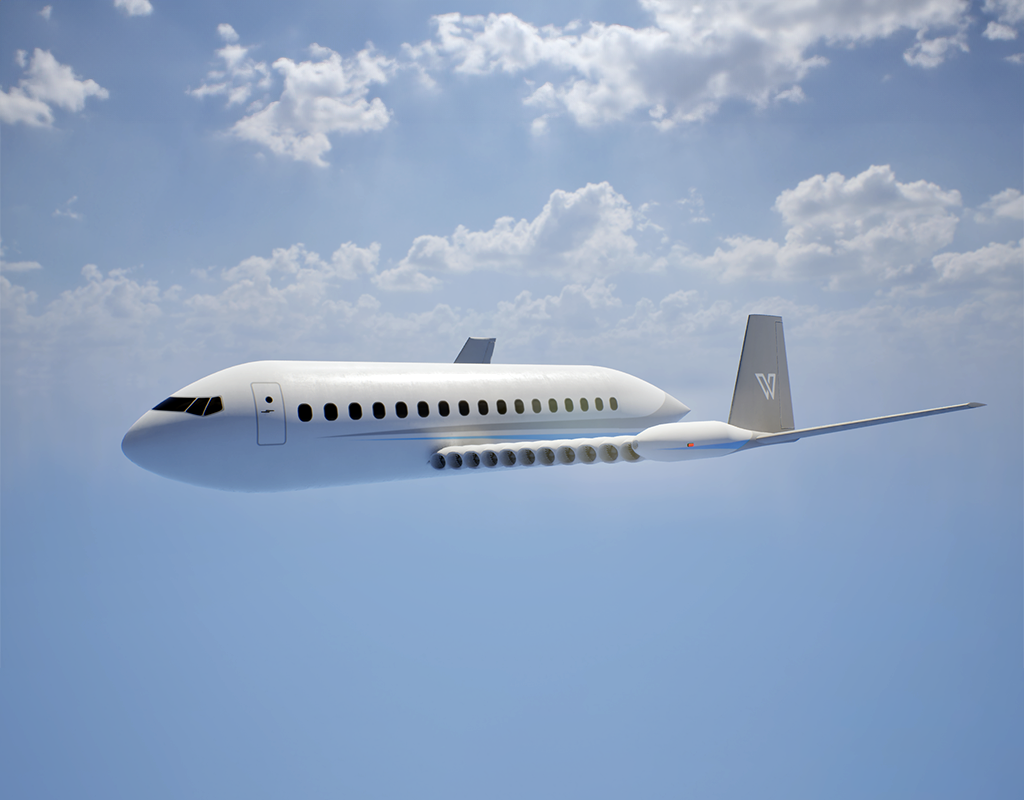
During this week’s Ohio Air Mobility Symposium (March 4th-5th), Whisper Aero CEO, Mark Moore, delighted the audience by revealing his vision of a 100 seat commercial aircraft concept that the company is calling the “Whisper Jetliner”, reports a press release.
While sharing a panel with Robin Riedel, co-leader of the McKinsey Centre for Future Mobility, under the heading ‘Perspectives on AAM Progress: a Fireside Chat’, Moore explained the concept utilises a larger version of Whisper’s ultra-low noise electric ducted fans integrated into a wing to achieve Upper Surface Blowing.
He referred to this integration as “a jetfoil” because the propulsion system is embedded directly into the wing airfoil while being distributed across its entire leading edge.
The release says, “Ultimately, Whisper sees this as a north star for where their propulsion systems can achieve major reductions in carbon emissions across the core aviation market.”
It goes on, “The jetliner concept leverages an outboard horizontal tail configuration for improved aerodynamics, lower noise at all flight phases, and shorter takeoff and landing field lengths of <3000 ft. Integration of Whisper’s electric ducted fans along the leading edge of a wing increases the aircraft’s wing loading by >20% to increase the cruise high speed lift-to-drag ratio from 17.5 to 22.
“This decreases energy use, and subsequently, direct operating cost while improving passenger ride quality. Whisper has taken learnings from its studies on near-term regional air mobility concepts like its 9 passenger Whisper Jet concept to generate directly applicable insights to much larger aircraft.”
Through these innovations, Whisper is able to maintain a 27 percent T/W for the aircraft overall with fan pressure ratios closer to 1.2, as opposed to 1.4 with today’s geared turbofans. The reduction in this pressure ratio increases overall propulsive efficiency allowing regional aircraft to operate with 804 Wh/kg batteries (cell-level, 2050 projections assuming 3.6 percent improvement year over year) for energy in combination with a 4 MW series hybrid for reserves to achieve battery electric ranges up to 769 miles while satisfying FAA Instrument Flight Rule missions.
As an example, a 700 mile Jetliner flight enabled by Whisper’s propulsion systems at full capacity, would save 9,100 kg of CO2 each flight, nearly 10 tons, as compared to a similarly sized aircraft flying today.
Recharging the batteries requires 45 minutes with 14 MW chargers, which is the typical turnaround time for similarly sized aircraft today. Yet, the charging and discharge rates are only .7C, enabling high battery cycle life.
Energy costs for a typical 500 mile trip are USD733 for the Whisper Jetliner (@USD07 kWhr industrial electricity rates) compared to USD2,100 (@USD2.00/gallon JP fleet based fuel price) for an equivalently sized current commercial aircraft (e.g. Airbus A320-100).
The Jetliner concept can meet the range required at typical U.S domestic distances to reinvigorate regional airports across mid-sized cities. This spreads out air travel from congested major hubs and provides greater convenience and choice for shorter trips that occur more frequently than long distance journeys.
Also, quieter more efficient propulsion across Jetliner flights can further improve passenger experience and community friendliness. Lower noise at all phases of flight due to Whisper’s propulsive improvements can decrease cabin noise and reduce neighbourhood sound impacts, further increasing the amount of airports available to operators. Such flights will allow for these future jetliners to even operate at night for faster, more affordable cargo transportation.

The release continues, “The dramatic decrease in noise enables long sought after capabilities such as Intermodal fuselage concepts to be implemented to perform passenger operations during the day and cargo operations at night, with a 15 minute Quick Change capability through a cassette that replaces palletised seats with cargo containers. Such a capability increases the daily utilisation of the aircraft, enabling improved amortisation of fixed costs over more operating hours. Electric vehicles excel at achieving lower operating costs, so the combination of these approaches is highly synergistic.”
For more information

